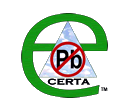 |
RoHS Compliancy News Releases |
Environmentally Certified Electronic Resale Trade Alliance |
 |
(Sep 26, 2007)
The Waste Electrical and Electronic Equipment (WEEE) directive mandates that OEMs make efforts to re-use, repair or re-cycle at least 50-80%, by weight depending on the category of products, of the products that they manufacture.
Process for converting leaded devices to lead free works, says study
Gina Roos
(August 28 2007)
Bloomington, Ind. - A joint study conducted by E-Certa Inc. and Sanmina-SCI shows it's possible to re-use lead- (Pb) containing parts by converting them to Pb-free for use in consumer-grade electronics. E-Certa has also released an information series based on the joint study that answers many questions posed by OEMs and engineers after the European Union's Restriction of Hazardous Substances (RoHS) directive imposed a new standard for product design by restricting the use of several materials including lead.
WEB PRESENTATION OFFERS INFO ON PROCESS FOR ROHS COMPLIANCE
(April 2007 )
A process for converting semiconductors and ICs to RoHS compliance is described in a new flash presentation available for viewing on the E-Certa Inc. web site.
European RoHS directive may cause component inventory misalignment
(January 2007 )
Many experts predict severe inventory misalignment as a result of the European Union's Restrictions on Hazardous Substances (RoHS) directive to eliminate lead from solder, according to experts at the Environmentally Certified Electronic Resale Trade Alliance (E-CERTA) in Bloomington, Ind.
Half of electronic product companies plan to convert component for RoHS compliance
(Jan 10, 2007 )
52% according to recent TFI benchmarking study
In the benchmarking study Gauging Environmental Preparedness and Recommendations for Best Practices (by Technology Forecasters Inc., December 2006), approximately half of the electronic-product companies' surveyed are converting or plan to convert the leads of some lead (Pb) components to Pb-free, and/or from Pb-free to Pb--to make use of available components.
E-Certa receives laboratory accreditation and ISO17023 certification from A2LA (from 10/2006 - 03/2012)
(December 19 2006)
In October, the American Association of Laboratory Accreditation audited the XRF testing processes at E-Certa, a laboratory providing the services of converting semiconductors from lead (Pb) to lead-free and vice versa (for RoHS-exempt applications).
When Removing Hazardous Substances from Electronic Components Makes Sense Technically and Economically
Ray Franklin, RoHSwell.com
(November 9 2006)
I first became aware of E-Certa in March of 2006. The idea of converting Pb-bearing parts to RoHS compliance was intriguing. Later, when I saw that a number of companies were applying for RoHS exemptions based on lifetime buys of Pb-containing parts, I thought that was odd given the E-Certa solution. This was clearly a case of "adaptation to scientific and technical progress" that was being ignored by the industry. This interview with Joel Deutsch explains the conversion process and how it can solve the lifetime buy dilemma.
Delidding verifies chip authenticity
By Joel Deutsch, president, E-Certa
(October 30 2006)
Counterfeiters are having a field day with electronics. Even material content marking is subject to counterfeiting since counterfeiters may mark devices "no lead" when in fact they are leaded, and vice versa. This is why some suppliers are making delidding a necessary step to verify chip authenticity.
E-Certa Leverages Strategy, Research, and Industry Network to Deliver Supply Chain Sanity
(October 2006)
When the RoHS Directive finally came into effect in July 2006, electronics manufactures wishing to do business in Europe needed to comply. While the global supply chain adjusts to delivery of safer and more environmentally sustainable electronic products, many companies may face serious disruptions in their supply chain. Additionally, with increased reliance on remote component suppliers and contract manufacturers, there is a growing risk of counterfeit parts going into end products.
E-Certa offers services to address coming challenges
(August 4 2006)
Many experts predict severe inventory misalignment as a result of the European Union's- Restrictions on Hazardous Substances (RoHS) Directive. Producers that have not managed their component supply chain with precision accuracy may find themselves left with inventory that is no longer usable. Conversely, companies with products that are exempt from the legislation may find shortages of non-RoHS compliant components.
Reasons increase to check authenticity of components
(July 27 2006)
Hazardous-substance restrictions, counterfeit risk, and wrong parts
"Don't judge a book by its cover" has never been more apt among electronics components as it is now. Electronic components' exterior packages may look alike, but the leads may contain lead when the systems-manufacturer is seeking to comply with lead-free requirements, or the chip inside may be a counterfeit bought more cheaply by a third-party manufacturer, or a tape or bin of parts may just have been accidentally swapped at the dock or assembly line. "De-lidding" is an increasingly popular service to ensure that the parts used are the parts specified; the service includes lift the lid of a component package and using a metallurgical microscope--with software for a camera hook up--to capture images of the die inside the package, to check for authentic identification.
Now that the RoHS directive's deadline is upon us - best 7 options for getting economic value from non-compliant parts

Watch the Video Learn about component conversion - a physical process to convert Pb status of components. |

Regulatory compliancy or litigation - the choice is yours. |

RoHS Compliancy
The first step on your pathway to meeting your "due diligent" requirements or RoHS compliancy. |
